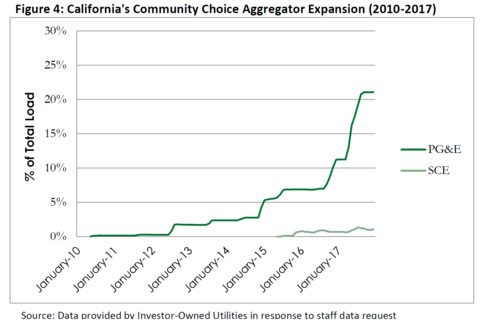[Source: Bloomberg] California’s chief utility regulator is warning that the state could find itself in the throes of another energy crisis if it doesn’t address the droves of customers defecting from utilities.
The state is going to find it increasingly difficult to ensure it has enough electricity to keep the lights on as more Californians leave utilities to buy their power directly from resources like rooftop solar panels and community choice aggregators that contract directly with generators, California Public Utilities Commission President Michael Picker said. As much as a quarter of the state’s energy demand may be sourced outside of utilities by the end of this year, he said.
“We have a hodgepodge of different providers,” Picker said in a telephone interview. “If we aren’t careful, we could slide back to the kind of crisis we faced in 2000 and 2001.”

California report shows how community choice aggregators are gaining ever-increasing share of the state’s power load.
Source: California Public Utilities Commission
Almost two decades ago, California was gripped by an unprecedented energy crisis, brought on by electricity shortages and widespread market manipulation. Hundreds of thousands of homes and businesses were plunged into darkness amid rolling blackouts, wholesale electricity prices skyrocketed to record levels and the state’s largest utility, PG&E Corp.’s Pacific Gas & Electric, went bankrupt. The extensive outages hit just a few years after the state decided to open its electricity market to competition.
‘We Do Not Have a Plan’
Picker said he’d like to avoid making the same mistake. On Thursday, his staff published a report detailing how California is once again giving more choice to electricity customers. It offers some possible ways in which policy makers could address the shift, taking from experiences that other states and the U.K. have been through. Among them:
- Defining and designing a “provider of last resort” if a power supplier fails to deliver
- Reconsidering incentives for new energy technologies
- Re-examining how costs are allocated to ratepayers for power generation and distribution
The report “wrongly asserts today’s energy system lacks regulation and adequate planning,” according to an emailed statement Thursday from the California Community Choice Association, or CalCCA, which represents community choice aggregation providers.
“CCAs take seriously their obligation to meet California’s rules to ‘keep the lights on’,” Beth Vaughan, executive director of CalCCA, said in a statement. “CCAs are building their localized programs for the long term, with a commitment to reliability, affordability, decarbonization and social equity.”
Picker said the state is already suffering from its lack of preparation. Electric utilities aren’t sure how many customers they’ll have in the future and have become increasingly hesitant about signing long-term contracts with power generators, he said. Owners of natural gas-burning power plants, which often fire up to help supply electricity when demand peaks, are having a hard time making money.
“The central decision making that we use for keeping the grid reliable, safe and affordable is splintering,” Picker said in the state report issued Thursday. “In the last deregulation, we had a plan, however flawed. Now, we are deregulating electric markets through dozens of different decisions and legislative actions, but we do not have a plan.”
Source: Bloomberg
May 3, 2018


